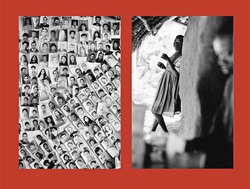The quiet “Nonetheless”
Photographs by M. Krizanovic at Artis Gallery, Darmstadt
Daily lives of Afghan Farmers, captured by Mirko Krizanovic
October 28 2004
Christoph Schütte, Frankfurter Allegemeine Zeitung
Sometimes, one picture is enough to understand what it all means: the news from afar, talking about war and escape, a “precarious situation” or normalization. Never have there been more images from the world’s crises areas nor have we been better informed, but these events often remain strangely abstract. Afghanistan, for example. Peter Struck once proclaimed, that since Germany is being defended at the Hindukusch, Afghanistan, struck by war and civil war, by tyranny and terror, has been brought closer. But little is known about the people, their every day lives, their hopes and fears, their worries and bits of happiness.
It is photographers like Mirko Krizanovic who, with their work, are able to tell those stories that usually disappear behind the headlines. As photojournalist and editorial staff photographer for the newspaper FAZ from 1987 until 1994, he mainly used to do classic photo reporting in black and white. Continuously interested in people, he always met them with respect and never infringed on their dignity even under the most miserable conditions. Krizanovic selected just 10 images, taken in Afghanistan this year, along with 70 photographs from the last 10 years, for a total of 80 pieces to be shown in the exhibition at the Artis Gallery in Darmstadt (Prinz Christians Weg 1).
One of these shows students from an all-girls school in Kundus, facing the camera with a mixture of curiosity and pride, shyness and suspicion; or workers at a grist mill, which looks almost like it’s from the Middle Ages; or a war widow, completely covered in her Burka, kneeling on the ground, begging; or that farmer, who works his field with a wooden how, accompanied by his son. Krizanovic captured humble scenes from every day life – and yet, it reflects over 20 years of war and civil war, suffering and misery and – again and again – optimism and renewed hope for us to see.
His photographs, be they from Russia or Uzbekistan, from Africa or Kosovo, do always offer a remarkable eye for detail. Krizanovic is a master in zeroing in on his subject; he seems to always surmise the very instant that changes a mere photo document into a picture that is able to tell more that it shows.
This is just as true for his selection of powerful photographs from Albania and the Kosovo as it is for his images from Uganda. And finally here, we can see an example what Krizanovic’s photography can achieve by using one subject, which didn’t get noticed in the public media. He arranged two basically uninteresting prints like an enormous triptych: one the image of a pin wall with hundreds of passport photos and the other an image of a girl in a village near the Sudanese border. What you see, and what the viewer can’t imagine but nonetheless surmise, is the quiet drama of a decade-old fight against trypanosomiasis (African meningitis). And as so often, it is the quiet “nonetheless”, the ounce of optimism arising from the photographs that touches us deeply. Krizanovic’s photographs tell of people, without exposing them and without striking a false cord – and that’s the secret of his art.




